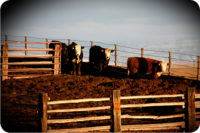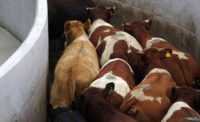FSIS directive clarifies inhumane-handling definitions






This 40-page document provided much-needed clarification on several potential animal welfare-related issues in livestock slaughter facilities. One of the more impactful additions to the directive was a descriptive definition of “egregious inhumane handling,” which includes “any act or condition that results in severe harm to animals.” Here is the list of examples that the directive provides:
1. Making cuts on or skinning conscious animals;
2. Excessive beating or prodding of ambulatory or nonambulatory disabled animals or dragging of conscious animals;
3. Driving animals off semi trailers over a drop off without providing adequate unloading facilities (animals are allowed to fall to the ground);
4. Running equipment over conscious animals;
5. Stunning of animals then allowing them to regain consciousness;
6. Multiple attempts, especially in the absence of immediate corrective measures, to stun an animal versus a single blow or shot that renders the animal immediately unconscious;
7. Dismembering conscious animals, for example, cutting off ears or removing feet;
8. Leaving disabled livestock exposed to adverse climate conditions while awaiting disposition, or
9. Otherwise causing unnecessary pain and suffering to animals, including situations on trucks.
Simply put, the examples of egregious inhumane handling are all examples of non-compliances with the Humane Methods of Slaughter Act of 1978 and the associated regulations of 9 CFR section 313. The value of such a descriptive definition is the addition of clarity regarding unacceptable handling procedures in plants.
The directive also added clarification regarding the jurisdiction of FSIS personnel with respect to loads of livestock that are waiting to unload. The directive clearly states that “Once a vehicle carrying livestock enters, or is in line to enter, an official slaughter establishment’s premises, the vehicle is considered to be part of that establishment’s premises.”
This means that a truckload of livestock that is waiting on a side street off the plant’s property but is clearly in line to unload is considered part of the plant’s premises, and that the plant must take responsibility for the care and handling of animals on that trailer at that time.
In addition to the provision of clearer definitions, the directive was also provided to guide inspection-program personnel in working with slaughter establishments that have implemented a systematic approach to animal welfare.
If you’re not familiar with the systematic approach to animal welfare, another way to describe it is, “a HACCP plan for handling and stunning livestock in slaughter facilities.”
The purpose of the systematic approach is to develop an analysis of potential hazards to animal well-being while those animals are in the slaughter facility, and an action plan to help prevent the hazards that have been identified. For plants that implement a robust, written, systematic approach to animal welfare and demonstrate consistent compliance with their program, the FSIS can allow the plant to return to operation without a suspension if an animal-welfare issue arises that is clearly an anomaly.
This does not mean that the development of a systematic approach to animal welfare gives a plant a “free pass” when an egregious animal welfare issue arises. The event still must be documented by FSIS personnel. If egregious animal-welfare issues continue to occur, then further enforcement action will occur and a suspension will likely be issued.
Before a systematic approach to animal welfare can be considered robust, the program must:
1. Describe the procedures that the establishment will effectively implement to stay in compliance with the humane-handling regulations — What will the plant do to ensure animal-welfare compliance?
2. Describe the records that the establishment will keep to demonstrate that the program is being implemented as written — How the plant will ensure it is doing what the plan says?
3. Describe the records that the establishment will keep to demonstrate the program will effectively prevent identified potential non-compliances — How will the plant monitor animal welfare?
4. Describe the actions the establishment will take when it fails to implement the program as written or fails to prevent a non-compliance — What steps will the plant take when a deviation form the plan occurs?
5. Be available to inspection personnel for review
With many government documents, we are left asking, “What’s in it?” Now you know some of the content of Directive 6900.2 Revision 2 and how it may make life just a little easier for well-managed slaughter facilities.
Looking for a reprint of this article?
From high-res PDFs to custom plaques, order your copy today!









